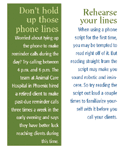6 ways to improve reminders
A++ clients make appointments the day they get your postcard, call, or e-mail. Here's how to help the others make the grade.
You send out postcards and make phone calls. And still some clients don't get their pets into your office. How do you reach those likely well-meaning but slow-off-the-mark pet owners? Try these strategies:

1 Make your reminders stand out.
You sort through three to six inches of magazines, catalogs, credit-card solicitations, and bills each day, right? Well, your clients do, too. So you need to do everything you can to make sure they don't lump your postcard in with the junk mail—or stack it up with the other foot of paper that's sitting on the counter by the front door waiting for attention.
The first step: Determine which kind of postcard will stand out to your clients. If you use free stock from major manufacturers, even if it has your logo, you run the risk that it will get lost in the shuffle. "So many companies use that stock," says Tracy Dowdy, CVPM, the owner of Management Resource Group in Bedford, Texas. "You need something that will jump out."

Fine-tuning a typical reminder system
Dowdy recommends using a larger postcard and putting a photograph on the front. "A glossy, color photograph of a pet, professionally printed on a 5-by-7-inch postcard will be easier to distinguish from junk mail," she says.
If you print your own cards, some software systems let you put the patients' photos on the postcard. "We print a picture of the client's pet in the left-hand corner," says Lisa Yackel, CVPM, the practice manager at Case Veterinary Hospital in Savannah, Ga. "Our clients really like getting pictures of their pets in the mail. They put the photo on their refrigerators and never lose the card."
2 Get the client and patient involved.
Rick Schulkey, a practice manager at Madison Veterinary Hospital in Madison Heights, Mich., says another way to increase compliance is to have clients address their postcard reminders to themselves. "We hope seeing their own handwriting helps clients recognize the reminder when they receive it," Schulkey says.

Broader uses for reminders
You can also address the reminder to the pet instead of the owner to help distinguish the postcard from junk mail. To take this idea even further, write the whole card to the pet. For example, your postcard could open with:
3 Educate your clients.
"Your reminders need to do more than say it's time to visit," says Christine Merle, DVM, MBA, CVPM, a consultant with Brakke Consulting Inc. in Zionsville, Ind. "With all the information available about pet care, clients have become accustomed to getting more details. So explain the benefits of the services you're recommending and address any potential concerns."
For example, if you send reminders for annual exams, you could say, "Our comprehensive physical exam includes checking the ears, eyes, nose, teeth, heart, lungs, bones, joints, skin, and abdomen. Pets that are a bit older, on regular medications, or have had an illness should be examined at least twice a year."
If you need to do a urinalysis, your reminder could say, "We recommend a urinalysis yearly for all pets and an early renal disease screen for dogs that are more than 3 years old. Why a urinalysis? Pets can have hidden problems, such as urinary tract infections, urinary stones, kidney disease, and endocrine disorders. And problems left untreated may lead to significant illness and pain. Sample collection is usually easy and we get the test results back fast so we can address any problems quickly, if we need to." If you tell your clients about health benefits when you send the reminder, they're more likely to comply.
4 Think about tapping new technology.
"E-mail reminders work well for some clients, and I think more practices will eventually use them," Dr. Merle says. Of course, before you take this approach, you'd need to ask clients if they use e-mail regularly and whether they'd like to receive reminders this way. And then you'll have to collect their e-mail addresses.
To notify your clients of the change, Dr. Merle recommends posting or sending all clients a note that says: "Life is busy and we at ABC Animal Hospital want your pet to receive the best preventive care at the right time. That's why we're working to improve our reminder system. One new option: We can now send you e-mail reminders to replace the postcards sent to your home. Call our receptionists today to find out more."
One caution: Clients would probably expect that they could then use e-mail to contact you, too; it's a two-way street. And while e-mails may save you some money by reducing mailing costs, implementing these reminders may increase the staff time needed, Dr. Merle says. You also might not be able to go completely to e-mail, which could limit your cost savings.
5 Call for a win.
Many clinics incorporate phone calls into their reminder systems. The benefits: You can answer any questions the client has and set the appointment while on the phone. You also might learn that the client isn't intending to come back to the practice. At the very least, this saves you the time and money you've been spending trying to reach them. Ideally, you'd find out why they're not returning, so your team could learn from their feedback.
How do you make sure you're saying the right things? Write a script, Dowdy says. "That way, you can communicate knowledgeably about routine services," she says. One simple script for a physical exam might be like this:
"Good afternoon, Mrs. Jones. This is Susie from ABC Animal Hospital. I'm calling about Fluffy's physical exam. Pets age faster than people do, so having a physical exam every six months is like you having an exam every three and a half years. And, of course, pets can't tell us how they're feeling. So we'd like to schedule Fluffy's appointment as soon as we can to make sure she's staying healthy. Would you be available next week?" Then, be ready to answer any questions.
If you reach the answering machine, try saying, "Good morning, Mrs Jones. This is Susie from ABC Animal Hospital. I'm calling regarding Fluffy. We sent you a reminder last month because she's due for her wellness visit. We have an appointment available this week. Please call me back at your earliest convenience so we can schedule an appointment. Thank you, Mrs. Jones. We look forward to hearing from you and seeing Fluffy soon. Goodbye." Of course, you can modify the scripts to meet your team's needs. And you can personalize them to each client.
"If your client says she'll call back later, make a note and set a reminder to call again," Dr. Merle says. "And don't be afraid to ask if the client had that service performed elsewhere. It's a prime way to find out whether a customer service issue needs to be addressed."
6 Reach clients with pre-recorded messages.
Although automated phone systems haven't completely caught on yet, some companies say they can make as many as 1,500 calls in one day. You can record a message and enter the client's phone number, and the machine will deliver the message and give you a report on whether the contact was successful. If the system reaches a person rather than a machine, your client can push a button and talk to you directly. A disadvantage to using this system is that even though you can record your own message, clients may not like getting an automated voice message.
"It loses the personal touch that many clients are looking for," Dr. Merle says. "An automated tone from anyone reminds me of a telemarketer." The bottom line: You'll probably have better compliance calling them yourself, Dr. Merle says.
Focus on clients
Of course, your fundamental goal with a reminder system is to give pets the care they need. You're trying to make it easy for pet owners to care for their four-legged family members. So be sure that if you make a change, the new approach works well for clients. "Ask their opinions as they schedule an appointment or before they leave," Dr. Merle says. "Or conduct a survey, and include questions that are related to reminders."
Finally, make sure your clients understand that your goal is to meet their needs. After all, you're changing your reminders because you care about their pets' health and want to make their experience at your clinic as pleasant as possible. That, in itself, should win you some points.